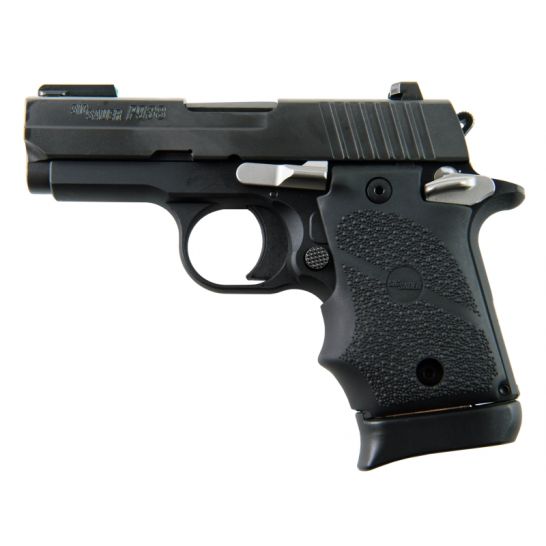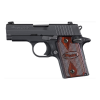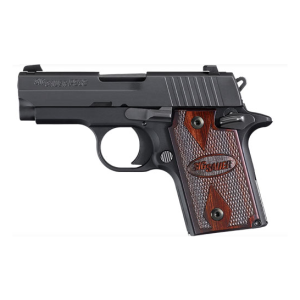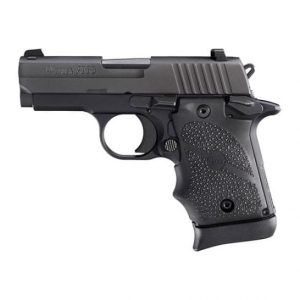Sig Sauer P938 9mm Sports 13 Pistol, Black For Sale
$499.99
The Sig Sauer P938 9mm Sports 13 Pistol in Black is a compact, all-metal firearm inspired by the 1911 design, based on the reliable P238® platform. Featuring a microcompact frame, it is ideal for concealed carry while delivering duty-caliber performance. The single-action only operation and slim 9mm design ensure a seamless shooting experience. Enhanced control is provided by a rubberized grip, while a fiber optic front sight and rear night sights improve visibility in different lighting conditions. The package includes two magazines for extended use, making this pistol a perfect blend of iconic design and modern functionality.
What are the cons of the SIG P938?
The SIG P938, though popular for its compact size and suitability for concealed carry, does have some drawbacks:
1. **Recoil Management**: Due to its small size and lightweight design, the SIG P938 can have a relatively sharp recoil, which might be uncomfortable or challenging for some shooters, especially during extended shooting sessions.
2. **Limited Capacity**: The P938 typically holds 6+1 or 7+1 rounds, which might be considered limited compared to some other compact firearms in a similar class that offer higher capacity.
3. **Price**: The P938 is generally more expensive than some other compact 9mm pistols, potentially making it less accessible to budget-conscious buyers.
4. **Size Limitations**: While its small size makes it easy to conceal, it also means the grip can be less comfortable for those with larger hands. This can affect the shooter’s ability to maintain a firm grip and control.
5. **Trigger Pull**: Some users report that the P938’s single-action trigger can be heavier than expected for a pistol of its type, which may affect precision for some shooters.
6. **Safety Features**: The P938 utilizes a thumb safety, and while some shooters appreciate this feature, others may find it cumbersome or worry about disengaging it quickly in high-stress situations.
7. **Durability Concerns**: Owners have occasionally reported issues with the long-term durability of certain components, necessitating maintenance or replacement of parts like springs or pins.
These cons might vary in significance depending on an individual shooter’s preferences and intended use for the firearm.
How many bullets does a SIG P938 hold?
The SIG P938 typically holds 6 rounds in its standard magazine, but there is an extended magazine option that can hold 7 rounds.
What SIG Sauer did Navy SEALs use?
The SIG Sauer P226 was the handgun historically used by Navy SEALs.
Is the SIG P938 a pocket pistol?
Yes, the SIG P938 is considered a pocket pistol. It is a compact, lightweight handgun designed for easy concealment and carry, making it suitable for use as a pocket pistol.
Is Sig better then Glock?
The question of whether Sig is better than Glock is subjective and depends on individual preferences and needs. Both Sig Sauer and Glock are reputable firearm manufacturers, known for producing reliable handguns. Here are some considerations that might help you decide which is better for you:
1. **Ergonomics**: Some users prefer the grip angle and feel of Sig Sauer pistols, while others favor the Glock’s grip design.
2. **Trigger**: Sig pistols often come with a smoother, more refined trigger out of the box, whereas Glock triggers are known for being simple and consistent but not as smooth.
3. **Reliability**: Both brands are known for producing highly reliable firearms. Glock has a reputation for simplicity and ease of maintenance, whereas Sig offers a more diverse range of features and finishes.
4. **Variety**: Sig offers a wider variety of models with features such as manual safeties and metal frames, whereas Glock is known for its consistency across models.
5. **Purpose**: The intended use can influence preference—whether for duty use, concealment, competition, or casual shooting.
6. **Price**: Glocks are generally more affordable, which can be a deciding factor for many buyers.
Ultimately, the “better” option depends on what aspects are most important to you in a firearm. It’s recommended to try both brands and see which feels and performs best in your hands.
Which Sig Sauer has issues?
Sig Sauer P320 has been reported to have issues, notably concerns about accidental discharges when dropped or impacted. These reports have led to lawsuits and safety debates around this model.
Does the Sig Sauer P938 have a safety?
Yes, the Sig Sauer P938 is equipped with a manual thumb safety.
What SIG Sauer did John Wick use?
In the John Wick films, John Wick uses the SIG Sauer P320 compact pistol.
What is the difference between single action and double action?
Single action and double action refer to the mechanisms in firearms, particularly in revolvers and semi-automatic pistols:
1. **Single Action (SA):**
– In single action firearms, pulling the trigger performs only a single function: releasing the hammer or striker to discharge the round.
– To fire in single action, the hammer must be manually cocked first (usually by thumbing back the hammer), which also rotates the cylinder in revolvers, aligning a fresh round with the barrel.
– An example is traditional single-action revolvers like the Colt Single Action Army and many early semi-automatic pistols.
2. **Double Action (DA):**
– Double action firearms allow the trigger pull to perform two functions: both cocking and releasing the hammer or striker.
– With a double action trigger, simply pulling the trigger will cock the hammer/striker and then release it to fire the round, without needing to manually cock it beforehand.
– This mechanism can be found in double action revolvers, like the Smith & Wesson Model 10, and certain semi-automatic pistols, often referred to as DA/SA (Double Action/Single Action), which means the first shot is double action and subsequent shots are single action.
The main difference lies in how the firearm is prepared to fire: single action requires manual cocking, while double action allows firing with just a trigger pull.
Should the safety be up or down on a Sig P938?
The safety on a Sig P938 should be in the “up” position to engage the safety. When the safety is up, the firearm is on “safe” and the trigger cannot be pulled. To disengage the safety and make the firearm ready to fire, the safety must be moved to the “down” position. Always ensure to handle firearms safely and according to the manufacturer’s instructions.
What are the flaws of the SIG P320?
The SIG P320 has been subject to several criticisms and reported issues. Here are some of the noted flaws:
1. **Unintentional Discharges**: One of the primary concerns with the P320 has been unintentional discharges. There have been reports and lawsuits claiming the firearm discharged without the trigger being pulled, particularly when dropped or struck in certain ways. SIG Sauer addressed this issue by offering a voluntary upgrade program to fix the trigger mechanism.
2. **Drop Safety**: Early models of the P320 were criticized for not being drop safe. Independent tests showed that the gun could fire if dropped at a specific angle or struck at the rear of the slide, leading to a redesign of the trigger and other components in later versions.
3. **Trigger Quality**: Some users have mentioned that the trigger can feel heavy or gritty out of the box, which might not be ideal for all shooters. This has led some owners to seek aftermarket trigger solutions to improve the feel.
4. **No Manual Safety**: Although some versions now include a manual safety, the lack thereof in many models is a point of contention for those who prefer having an additional layer of safety.
5. **Slide Finish**: There have been some reports of the slide finish wearing off relatively quickly compared to other brands, which could affect the gun’s aesthetics over time.
6. **Modularity Complexity**: While one of the P320’s selling points is its modularity, allowing users to change calibers, frame sizes, and grip modules, some users find the process complex or cumbersome, particularly for those not accustomed to firearm customization.
7. **Size and Weight**: Some shooters feel that certain P320 models are bulkier or heavier than comparable pistols, which might be a consideration for concealed carry.
Despite these criticisms, many users and law enforcement agencies have been satisfied with the SIG P320, appreciating its modularity, ergonomics, and overall performance.
Do sig guns jam?
Sig Sauer firearms, like all mechanical devices, can experience malfunctions, including jamming. However, they are generally known for their reliability, and many users report that they experience few issues under proper maintenance and use. Factors that can cause any gun, including Sig Sauer models, to jam include poor maintenance, using incorrect or faulty ammunition, and operational issues like “limp-wristing.” Proper cleaning, regular maintenance, and correct handling techniques can help minimize the risk of jams.
Is Kimber or Sig better?
Determining whether Kimber or Sig Sauer firearms are better depends on various factors, including personal preference, intended use, and specific firearm models. Both manufacturers are reputable and are known for producing high-quality firearms, but they tend to have different strengths:
– **Kimber**: Known for their precision-crafted 1911 handguns, Kimber firearms are often praised for their excellent fit and finish, accuracy, and smooth triggers. They are popular among those who appreciate traditional designs and aesthetics.
– **Sig Sauer**: Sig offers a wider range of firearms, including handguns, rifles, and more tactical models. They are known for reliability, innovation (e.g., the Sig P320’s modular design), and often feature newer technologies like optics-ready options and advanced ergonomics.
Ultimately, the better choice depends on what you prioritize in a firearm, such as aesthetics, innovation, or specific features. It’s advisable to try out models from both manufacturers to see which suits your needs and preferences better.
Be the first to review “Sig Sauer P938 9mm Sports 13 Pistol, Black” Cancel reply
Related products
Sig Sauer P938 9mm
Sig Sauer P938 9mm
Sig Sauer P938 9mm Pistol, Nitron SAO BLK u2013 938-9-BRG-AMBI




Reviews
There are no reviews yet.